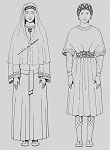| Please note that I have indeed scanned the photos of
extant garments and also of line drawings from books. I am fully aware
that I did not ask for permission to display them on this website, because,
in the case of the line drawings, I had only two photocopied sheets and
do not know where they come from. For the photos of extant garments: I
need to put up this page to be able to do more research on this subject
matter as soon as possible, for the sake of an accurate, authentic resconstruction
of Frankish-Kentish costume in the 6th and 7th centuries. Therefore I took
liberty to display the pictures, for purely academic research reasons.
I shall remove them immediately in case this is wished by the copyright
owners. Thank you for your understanding. |
I belong to the Living History Society Angelcynn,
which aims to recreate, as authentically as possible, the richness of the
birth of a nation which has passed into legend and into lore. The Society
was formed late in 1995, and aims to portray the life of the English people
in the period 400 - 900AD. This is all very well, but I am German, now
living in England, and thus have a German accent, and will always have.
Therefore, what is more logical, than to portray a Frankish character?
Especially since I am living in Kent and the society's centre is in Kent
just as well. The ties between Kent and the Frankish kingdoms were very
strong, and in cemeteries, like Mill Hill in Deal (near Dover) and Sarre on Thanet
there are many examples of Frankish influenced, or Frankish
gravegoods, indicating that Frankish, or Kentish-Frankish
costume was worn.
Therefore we have to look at continental Merovingian finds, where actually
remains of clothes and fabrics have been found, like Queen Arnegunde's
grave under the cathedral of St. Denis near Paris, the traditional burial
place of French/central Frankish Kings and Queens; or Queen Bathilde's
burial shirt, embroidered in chain stitch. But unfortunately, there isn't
much I was able to find in regard of the two ladies, let alone Frankish
costume in general, and even worse female costume. We do know roughly what the costume
would have looked like, BUT for an attempt at re-creating a garment as
authentically as possible, 'roughly' is certainly not enough.
Images open in a new window

|

|

|

|
|
Early 7th century
|
7th century, Grave 177, Pleidesheim
|
6th century, Arnegunde
|
Late 6th century
|
Thus I would like to present on these pages what I have found so far
about the costumes of the two ladies, one from the 6th and one from the
7th century.
 |
Thank you for every help and enjoy what is here,
Nicole
P.S. The costume worn on the photo is 6th century Anglo-Saxon. |
The 6th century Queen who was buried in St. Denis underneath the cathedral,
grave 49, could be identified as Arnegunde, consort of Clothar I by the
seal ring she wore. Gregory of Tours wrote about her; she was the second
wide of Clothar I (511-562) and mother of king Chilperic I (562-584). She
obviously died at the age of about 45 years, had fair hair and a prominent
lower chin, and was of short build.
The 7th century Queen came to the continent from England not as a wealthy
person, but as a slave, a chattel, an object. She was sold into Neustria,
where she was bought by a high ranking official. Later she was married
to King Clovis II, who was in his late teens at the time of marriage. And
yet history knows no romance in this, because it was a well-known and well-liked
practice to marry slaves, who did not have powerful alliances, no male kin
who could possibly threaten the throne. Nevertheless, she was obviously
treated well by Clovis, although he left an unsavoury name in the chronicles.
Bathilde used the wealth, which she now had at her command to found and
build up monasteries. And what is so important here is that in the seventh
century such establishments were not just islands of peace and comparative
security amid the violence, but centres of progressive education and mental
liberation for men and women alike.
Clovis died in 657 and she had borne him three sons, now becoming
the regent for the eldest of them, Clothar III, who wasn't even 7 years
old at the time of his father's death. She died in her monastery at Chelles.


Contents Copyright © N. Kipar 2000.
Graphics Copyright © N. Kipar 1999, 2000 apart from the background.
The fibulae depicted on the webgraphics are Frankish,
7th century
Two small photos of reenactors © Angelcynn.
With permission.
I do not know who owns the copyright to the drawings.
I only had a couple of pages copied from a German book.
Page created on 30th April 2000















